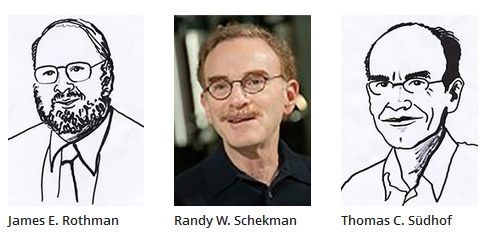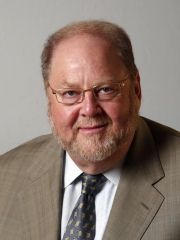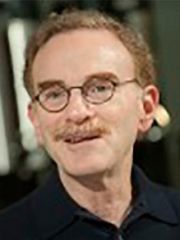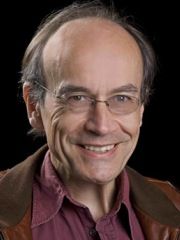 2013诺贝尔生理学或医学奖得主 诺贝尔奖官网消息,2013年诺贝尔生理学或医学奖7日下午揭晓,耶鲁大学教授詹姆斯-E.罗斯曼、加州大学伯克利分校教授兰迪-W.谢克曼及 德国生物化学家托马斯-C.苏德霍夫因在细胞内主要运输系统的新发现而获奖。诺奖委员会说,三人发现了细胞内囊泡交通的运行与调节机制。 生物体内每一个细胞都是一个生产和运输分子的工厂。比如,胰岛素在这里被制造出来并释放进入血液当中,以及神经传递素从一个神经细胞传导至另一 个细胞。这些分子在细胞内都是以“小包”的形式传递的,即细胞囊泡。这三位获奖科学家发现了这些“小包”是如何被在正确的时间输运至正确地点的分子机制。 兰迪-W.谢克曼发现了一系列与细胞囊泡输运机制有关的基因。詹姆斯-E.罗斯曼则发现了让这些囊泡得以与其目标相融合的蛋白质机制,从而可以实现对所运“货物”的传递。托马斯-C.苏德霍夫则揭示了信号是如何实现对囊泡的控制,使其得以精确分配其所载“货物”。 在这项发现过程中,三位科学家:罗斯曼, 谢克曼和苏德霍夫揭示了细胞内输运体系的精细结构和控制机制。这一系统的失稳将导致有害结果,如神经系统疾病,糖尿病或免疫系统紊乱。 获奖者简介: 詹姆斯-E.罗斯曼  罗斯曼 1947年出生(66岁),耶鲁大学细胞生物学系系主任、纪念Fergus F. Wallace生物医学教授。曾获多种荣誉,包括哥伦比亚大学的露依莎-格罗斯-霍维茨奖、拉斯克奖基础医学奖(2002年)、费萨尔国王奖。 兰迪-W.谢克曼  谢克曼 1948年出生(65岁),加州大学伯克利分校细胞生物学家,曾任《美国国家科学院院刊》主编。1992年当选美国国家科学院院士。2002年与詹姆斯-罗思曼因对细胞膜传输的研究获拉斯克基础医学奖。 托马斯-C.苏德霍夫  苏德霍夫
1955年出生(58岁),德国生物化学家,以研究突触传递知名。自1986年以来聚德霍夫博士的研究已经阐明了许多主要的蛋白介导突触前功能。2013年和理查德-舍勒分享了拉斯克基础医学奖。 诺贝尔奖官方发布的获奖理由 Traffic congestion reveals genetic controllers Randy Schekman was fascinated by how the cell organizes its transport system and in the 1970s decided to study its genetic basis by using yeast as a model system. In a genetic screen, he identified yeast cells with defective transport machinery, giving rise to a situation resembling a poorly planned public transport system. Vesicles piled up in certain parts of the cell. He found that the cause of this congestion was genetic and went on to identify the mutated genes. Schekman identified three classes of genes that control different facets of the cell´s transport system, thereby providing new insights into the tightly regulated machinery that mediates vesicle transport in the cell. Docking with precision James Rothman was also intrigued by the nature of the cell´s transport system. When studying vesicle transport in mammalian cells in the 1980s and 1990s, Rothman discovered that a protein complex enables vesicles to dock and fuse with their target membranes. In the fusion process, proteins on the vesicles and target membranes bind to each other like the two sides of a zipper. The fact that there are many such proteins and that they bind only in specific combinations ensures that cargo is delivered to a precise location. The same principle operates inside the cell and when a vesicle binds to the cell´s outer membrane to release its contents. It turned out that some of the genes Schekman had discovered in yeast coded for proteins corresponding to those Rothman identified in mammals, revealing an ancient evolutionary origin of the transport system. Collectively, they mapped critical components of the cell´s transport machinery. Timing is everything Thomas Südhof was interested in how nerve cells communicate with one another in the brain. The signalling molecules, neurotransmitters, are released from vesicles that fuse with the outer membrane of nerve cells by using the machinery discovered by Rothman and Schekman. But these vesicles are only allowed to release their contents when the nerve cell signals to its neighbours. How is this release controlled in such a precise manner? Calcium ions were known to be involved in this process and in the 1990s, Südhof searched for calcium sensitive proteins in nerve cells. He identified molecular machinery that responds to an influx of calcium ions and directs neighbour proteins rapidly to bind vesicles to the outer membrane of the nerve cell. The zipper opens up and signal substances are released. Südhof´s discovery explained how temporal precision is achieved and how vesicles´ contents can be released on command. (责任编辑:泉水) |
美德三名科学家分享诺贝尔生理学或医学奖
时间:2013-10-07 19:20来源:news.sina.com.cn 作者:泉水
顶一下
(0)
0%
踩一下
(0)
0%
------分隔线----------------------------
- 上一篇:汤森路透发布2013年诺贝尔奖预测名单
- 下一篇:中科院专家解读今年诺贝尔医学奖
- 发表评论
-
- 最新评论 进入详细评论页>>
- 推荐内容
-
- 2023诺贝尔医学奖得主卡塔琳·考里
瑞典卡罗琳医学院2日宣布,将2023年诺贝尔生理学或医学奖授予...
- “诺奖得主”大隅良典获2017生命科
大隅良典(中)和家人 当地时间12月4日(北京时间12月5日),有...
- 中国女科学家屠呦呦和另外二位科
诺贝尔生理学或医学奖从1901年开始颁发,第一位获奖者是埃米尔...
- 诺奖团队再下一城:给细胞拍高清
刚刚获得2014年诺贝尔化学奖的艾力克·贝齐格,又带领自己的团...
- 美德三名科学家分享诺贝尔生理学
2013诺贝尔生理学或医学奖得主 诺贝尔奖官网消息,2013年诺贝尔...
- 诺贝尔奖背后的失落者
在诺贝尔科学奖评选的历史上,争议和缺憾始终伴随其中。今年...
- 2023诺贝尔医学奖得主卡塔琳·考里
